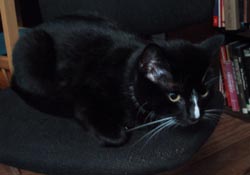
bat pose
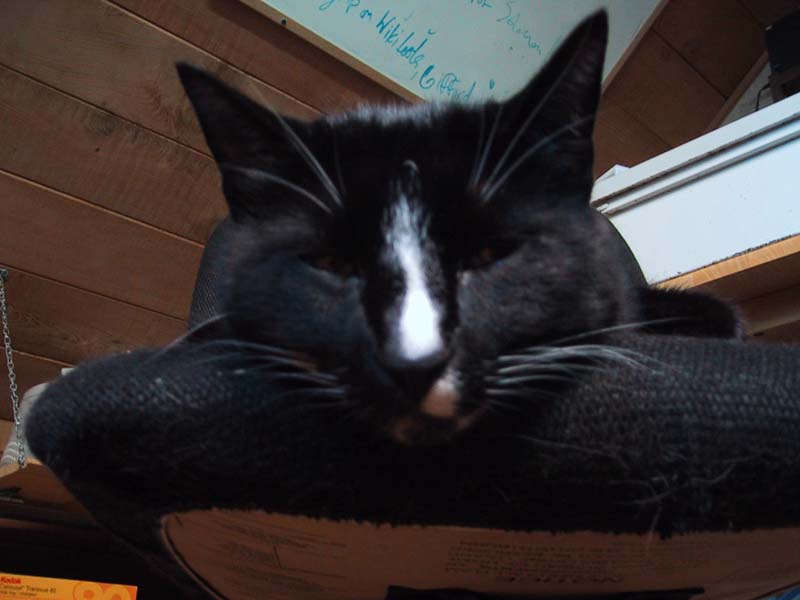
meditation
I recently came upon a plaintive little notice stapled to a utility pole :
Missing + Scared !
“Ollyver” the brown cat !
He fell out of the window + is hurt.
He is big, brown with stripes and spots.
$1000 REWARD
A thousand dollars is enough to buy dozens of cats, but that is not the point. The disappearance of my namesake, “Ollyver” has left a hole in someone’s heart.
Over at F-Train, Paul Ford posts a moving eulogy to his cat ‘TK,’ whose “thumb-sized heart” suddenly stopped beating while he was having his belly stroked on the floor of Ford’s New York apartment.
In Whitby, Ontario, the owners of a deaf, white cat (also curiously called “Oliver”) mourn over his death. He was, according to his owners:
“the softest and just . . . the best.”
There is something singularly poignant about the loss of a cat, even when it doesn’t share my name.
The filmmaker’s filmmaker Chris Marker, frequently incorporates cats in his films and is said to respond to requests for his photograph with a picture of a cat. In the narration to his (1983) film Sans Soleil he tells us:
In the suburbs of Tokyo there is a temple consecrated to cats. I wish I could convey to you the simplicity, the lack of affectation when a couple comes there on behalf of their missing cat, Toro; the lack of affectation can’t be captured on film.
The raw emotion with which we love our cats reflects our deep longing to inhabit their animal alterity – a longing, which by its very nature can never be consummated. When we share our lives with them, sometimes, we get just the briefest glimpses into what it might be like to be them -or at least we think we do- and that is enough to beguile us forever. But the territory in which our lives intersect is tentative and conditional. When cats abandon us, when they die or succumb to wanderlust, our consciousness is quickly reeled back into its own human torment. The sad and certain thing is that we will never really know them.
The cats populating Marker’s films stare out at us from the screen, timelessly and omnisciently, as if to say: “I pity you,” which of course they have every right to do. Yet, whether they are mincing through the ashes of an Icelandic volcano or through the ashes of Communism, Marker’s cats, like all cats, steadfastly remain just cats, intent upon killing the next bird or jumping onto the next warm lap, leaving us to stew in the dilemmas of history.
Our delight in cats seems to have a lot to do with our flip-flopping perceptions of them, oscillating between – “It’s an animal!” and “It’s a little man in a fuzzy sweater!”, or something like that. The cat’s ability to inhabit this interstice between ‘intimate’ and ‘other’ might have been what prompted Schrödinger to cast one in his famous thought experiment, in which a cat simultaneously exists in two states- alive and dead, when its destiny is ordained by quantum theory. To liberate the universe from this disconcerting paradox, my friend Anne named her cat “Schrödinger”, allowing it to occupy a third state, that of the Gedankenexperimentor himself, thus closing the teleological circle and allowing us all to breathe a deep sigh of relief.
Of course quantum theory implies that getting too close to our cats invokes a kind of Heisenberg Uncertainty Principle in which our desperate tendency to anthropomorphize actually obliterates any possibility of understanding them. When carried to extremes, this can have a demented beauty of its own. Witness for example the following images from pet office’s site, the very embodiment of the saccharine Japanese concept of kawaii.
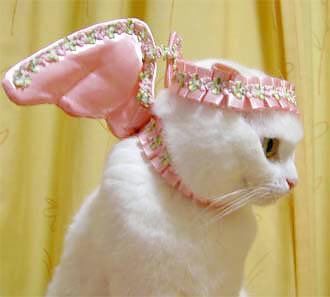
pop cupid
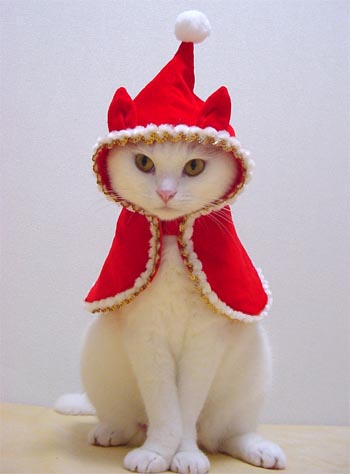
pop kirakira
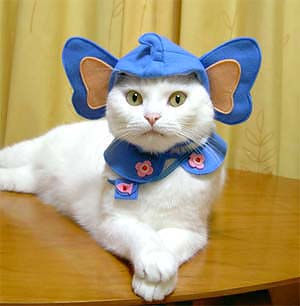
pop elephant
I don’t imagine that my cat Weens will be wearing a ‘pop kirakira’ outfit anytime soon. I once had the misguided notion to put a collar on him, in hopes that the two little bells I had attached would warn defenseless birds of his approach. The arrangement lasted less than a week. One morning, in the middle of some urgent computer work, I had to banish Weens from my office, as he was in one of those moods where he was trying rather imperiously to command my lap. I put him out in the hall and shut the door, thinking that that would be the end of it. A few minutes later, his collar, bells and all, came skidding under the office door, landing with a tinkle at my feet. The message was obvious: I was as much his pet as he was mine and I had not lived up to my end of the bargain. Weens is the living embodiment of the old adage that cats are the only animal to have domesticated people, or more succinctly:
“Dogs have masters. Cats have staff”
Although unapologetically an animal, casually snapping the neck of a rat one minute and soliciting a belly rub the next, Weens does occasionally exhibit, what to me are, rather astonishing feats of cognition. Some time ago, my friend Sue came over to my house, along with her 3-year-old son Joseph. While we were chatting, Joseph started scrabbling up the back of a rather rickety chair to try and see my softshell turtle, swimming in its aquarium, well above his eye level. Joseph, understandably, got upset when we plucked him off of this unstable arrangement, just as he was about to get a good look. Within seconds, Weens, who had quietly been watching the commotion, scampered over to the windowsill, picked up a small wooden model of a turtle in his mouth and brought it over to Joseph. We were speechless. Did Weens understand the language of symbols?
In between episodic bursts of semiotic bravura, Weens spends the majority of his time, in typical cat fashion – sleeping, eating and destroying the furniture. He has however adopted the rather singular affectation of staring into space with his limbs folded under him akimbo, giving him the appearance of a demented fruit bat. When he sits like this, he appears to be thinking. What I wouldn’t give for a just one peek inside his mind . .


